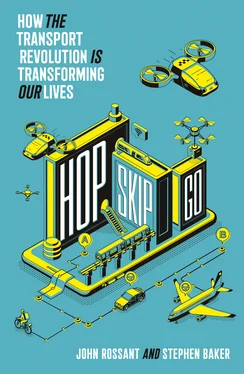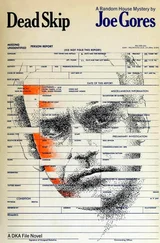The day that Bird launched in Santa Monica, VanderZanden was still bankrolling the company with just a small round of angel funding. But that changed quickly. Within weeks he had attracted $15 million in VC money, and another $100 million soon after that. By early 2018, when the company agreed to pay a $300,000 fine to the city, its valuation topped $1 billion. By that point, the Santa Monica fine was something Travis VanderZanden could have jammed into a tip jar. He had an enthusiastic customer base, a plan to expand nationally, and a fearsome fortune. Cities would take him on at their own peril.
This model extends throughout the tech economy. Giants like Amazon, Google, and Facebook have behaved like jumbo versions of Bird. They start by providing valuable services to billions, at low cost or for free. Largely unencumbered by government regulations in their early years, they go on to build market capitalizations bigger than entire industrial economies. In a Vice News feature, Euwyn Poon, cofounder of the San Francisco scooter company Spin, called this “innovating on the regulatory side.”
What’s more, because of the services they provide, these tech companies are often more popular than governments, more trusted, and widely viewed as essential. It’s often when something goes wrong—when their autonomous machines kill someone, or a tech platform is used to spread lies or hack an election—that governments can start to regulate them. But by that point, the tech companies can fight back, with their legions of customers, advertising might, and armies of lobbyists.
This build-first, fix-later model could spell catastrophe in the mobility revolution, and especially in car towns like LA. Seleta Reynolds envisions autonomous pods, pimped out as rolling lounges, carrying people on joyrides at low prices. These pods could be small bars or restaurants, game pods with virtual reality hookups, even smoking chambers offering rich selections of California’s legal marijuana. The skies could be black with drones, some of them flying across the Santa Monica Mountains just to pick up tacos or a roll of toilet paper.
If governments fail to assert their control with taxes and regulations, cheap, ubiquitous mobility services could overwhelm the entire region, much the way the automobile did.
STILL, AFTER A century of the automobile monoculture, the region’s mobility revolution also offers opportunities to tackle some of LA’s toughest challenges, including homelessness. According to Zillow, the real estate database company, a median-earning family in Southern California must pay a staggering 46.7 percent of its income to rent median-valued housing. This is the highest such rate in the country. Some 130,000 households can no longer afford this expense and are transient or homeless. The most vivid display of this scourge is the sprawling LA tent city known as Skid Row. It occupies a square mile between downtown and the Arts District and is home to some ten thousand people in wretched conditions.
As we mentioned earlier, the physical structure of LA favors cars, in many ways, over people. But as Angelenos find other ways to move around, many of them will be left with a legacy of the automobile age: the garage. Steven Dietz, a leading venture capitalist based in Santa Monica, recently launched a start-up called United Dwelling. The business plans to convert unused garages into affordable housing. With the right incentives, he says, this could dramatically expand the housing supply within LA, reducing its century-old sprawl.
It doesn’t even have to wait for the air taxis, speeding underground trains, or other wonders of the coming age of mobility. Not long ago, Dietz, who also teaches at the University of Southern California, had his students knock on doors in LA to find out what people kept in their garages. In a study of seven hundred residences, all of them with two-car garages, only 8 percent of homeowners kept their cars in the garage. “The rest of them parked in the driveway and used the garage to store their stuff,” he says, laughing.
“This could work,” says Mayor Garcetti, back at his office. He does some quick math. “We have five hundred thousand single-family homes in LA,” he says. “If ten percent of them could convert their garages, that would be fifty thousand new housing units.”
The real estate opportunity extends far beyond family garages. The Los Angeles International Airport, known as LAX, is currently building a parking garage with 4,500 badly needed spaces. But as travelers find different ways to reach the airport, from Metro and ride-shares to flying taxis, those parking spaces might go begging. With an eye to that shift, says Justin Erbacci, chief innovation officer at LAX, the new parking lot is designed to be converted to either retail space or housing. “We’re making flat floors and higher ceilings,” he says. Instead of building the ramps inside the building, Erbacci’s team placed them on the outside, where the erstwhile garage, when the time comes, can shed them.
This is what the mobility revolution has in store for LA. It’s a real estate story, as it always has been. The value of each piece of land, and the use for it, depends largely on how people can get there, and where they can go. This was the case in the era of streetcars, and again in the century dominated by the automobile. Once more, changing mobility is poised to reshape life and geography in Southern California.
Конец ознакомительного фрагмента.
Текст предоставлен ООО «ЛитРес».
Прочитайте эту книгу целиком, купив полную легальную версию на ЛитРес.
Безопасно оплатить книгу можно банковской картой Visa, MasterCard, Maestro, со счета мобильного телефона, с платежного терминала, в салоне МТС или Связной, через PayPal, WebMoney, Яндекс.Деньги, QIWI Кошелек, бонусными картами или другим удобным Вам способом.












